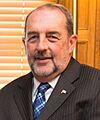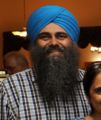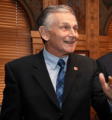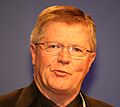Conservative Party of Canada facts for kids
Quick facts for kids
Conservative Party of Canada
Parti conservateur du Canada
|
|
|---|---|
 |
|
| Abbreviation | CPC |
| Leader | Pierre Poilievre |
| President | Stephen Barber |
| Deputy leaders |
|
| Senate leader | Don Plett |
| House leader | Andrew Scheer |
| Founders | |
| Founded | December 7, 2003 |
| Merger of |
|
| Headquarters | 1800–66 Slater Street Ottawa, Ontario K1P 5H1 |
| Membership (2022) | |
| Ideology | Conservatism (Canadian) Economic liberalism |
| Political position | Centre-right to right-wing |
| Regional affiliation | Asia Pacific Democracy Union |
| Continental affiliation | Union of Latin American Parties (associate party) |
| International affiliation | International Democracy Union |
| Colours | Blue |
| Senate |
12 / 105
|
| House of Commons |
120 / 338
|
The Conservative Party of Canada (often called the CPC) is a major political party in Canada. People sometimes call its members "Tories" or simply "Conservatives." The party was created in 2003. It formed when two other big parties, the Progressive Conservative Party and the Canadian Alliance, joined together.
The Conservative Party is generally seen as a centre-right to right-wing party in Canadian politics. This means their ideas are often more traditional and focus on things like lower taxes and individual freedom. They are different from the Liberal Party of Canada, which is usually seen as more left-leaning. The Conservatives are known as a "big tent" party. This means they welcome many different kinds of members with various ideas.
Before 2003, there was an older Conservative Party that existed from 1867. It changed names over time. By 1942, it was known as the Progressive Conservative Party. In the 1993 election, many voters in Western Canada started supporting the Reform Party instead. Since neither the Progressive Conservatives nor the Reform Party (or its later version, the Canadian Alliance) could beat the Liberals, they decided to join forces. This led to the creation of the modern Conservative Party of Canada in 2003.
From 2006 to 2015, the Conservative Party was in charge of Canada. Their economic plans included lowering sales and income taxes. They also worked to balance the national budget. They created special savings accounts called TFSAs. In social areas, they removed the long-gun registry. They also made rules for tougher sentences for violent crimes. The government also supported Israel and worked on big trade deals with other countries.
The first leader of the party was Stephen Harper. He led the party to win two minority governments in 2006 and 2008. A minority government means they had the most seats, but not enough to make decisions without support from other parties. In 2011, they won a majority government. This means they had enough seats to pass laws easily. But in 2015, they lost to the Liberal Party. Since then, the Conservatives have been the main opposition party. Their leaders after Stephen Harper were Andrew Scheer and Erin O'Toole. In 2022, Pierre Poilievre became the new leader.
Contents
What the Conservative Party Believes In
The Conservative Party is still quite new, but it has a mix of different ideas. It's called a "big tent" party because it includes many different viewpoints. These views are generally on the centre-right to right-wing side of politics. They focus on Canadian conservatism and careful spending of money.
When the party was formed, they set out their main beliefs. These include:
- Being responsible with money.
- Protecting individual rights and freedoms.
- Supporting Canada's constitutional monarchy and democratic system.
- Having a strong national defense.
- Believing in law and order.
- Respecting Canada's history and traditions.
- Treating all Canadians equally.
Party Ideas and Plans
In recent years, the Conservative Party has often talked about these plans:
Culture
- Supporting bilingualism (having two official languages, English and French).
Canada's Constitution
- Supporting federalism (different levels of government working together).
- Being against Quebec separatism (Quebec leaving Canada).
- Wanting to keep Canada's constitutional monarchy.
- Wanting Senators to be elected by people, not chosen.
- Protecting freedom of speech, religion, and the press.
- Respecting agreements with Indigenous Canadians.
- Allowing Indigenous communities more control over their own lands.
Money Matters
- Supporting supply management for some farm products like dairy and poultry.
- Encouraging the extraction of petroleum and natural gas.
- Building more pipelines.
- Believing in the right to own private property.
Protecting the Environment
- Giving money for carbon capture technology.
- Stopping raw sewage from being dumped into rivers.
- Creating protected areas in the ocean.
- Setting limits on pollution for industries.
Firearms
- Keeping the system for licensing gun owners.
- Keeping bans on certain types of handguns and fully automatic firearms.
- Opposing bans on long-barreled handguns and semi-automatic firearms.
Fairness for Everyone
- Believing in equal opportunities for men and women.
Healthcare and Social Programs
- Supporting publicly funded healthcare for everyone.
- Keeping the Canada Pension Plan program.
- Reducing funding for the CBC (Canada's public broadcaster).
Immigration
- Connecting immigration levels to how many homes and jobs are available.
- Wanting to end birthright citizenship (being a citizen just because you were born in Canada).
- Being against illegal immigration.
Military
- Wanting to spend more money on Canada's military.
Taxes and Spending
- Reducing income taxes.
- Allowing families to split their income for tax purposes.
- Reducing business taxes.
- Reducing taxes on investments.
- Being against a carbon tax.
- Making taxes simpler.
- Having laws to make sure the government's budget is balanced.
- Reducing the national debt.
- Reducing money given to businesses by the government.
How the Party is Organized
National Council
The National Council is the top governing group of the Conservative Party. Stephen Barber has been its President since 2023. This council has 21 members from different parts of Canada.
Where the Party is Strongest
The Conservative Party has historically been strongest in Western Canada and in rural parts of Ontario. They are especially strong in Alberta, Manitoba, and Saskatchewan. They tend to be less strong in Quebec and Atlantic Canada, especially Newfoundland and Labrador and Prince Edward Island.
Youth Involvement
The Conservative Party does not have an official youth group. However, young people can become members and vote in party matters from age 14. The party also has clubs at various universities.
Party Leaders
The leader of the Conservative Party is a very important role. They often become the Prime Minister if their party wins enough seats.
| Leader | Start Date | End Date | Notes | ||
|---|---|---|---|---|---|
| Temporary |  |
John Lynch-Staunton | December 8, 2003 | March 20, 2004 | Was a Senator, served as temporary leader. |
 |
Stephen Harper | March 20, 2004 | October 19, 2015 | Was Prime Minister from 2006 to 2015. | |
| Temporary | 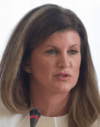 |
Rona Ambrose | November 5, 2015 | May 27, 2017 | Served as temporary leader. |
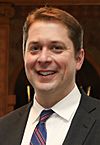 |
Andrew Scheer | May 27, 2017 | August 24, 2020 | Served as Leader of the Official Opposition. | |
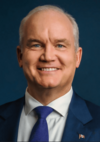 |
Erin O'Toole | August 24, 2020 | February 2, 2022 | Served as Leader of the Official Opposition. | |
| Temporary | 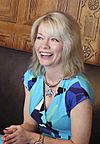 |
Candice Bergen | February 2, 2022 | September 10, 2022 | Served as temporary leader. |
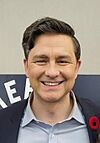 |
Pierre Poilievre | September 10, 2022 | Current Leader | Serves as Leader of the Official Opposition. | |
Deputy Leaders
The Deputy Leader is chosen by the party leader. Currently, Melissa Lantsman and Tim Uppal are the Deputy Leaders.
Party Presidents
The party president helps manage the party's operations.
- Don Plett (2003–2009)
- John Walsh (2009–2016)
- Scott Lamb (2016–2021)
- Robert Batherson (2021–2023)
- Stephen Barber (2023–present)
Conservative Members in Parliament
House of Commons
The Conservative Party has many members in the House of Commons. When they are not the government, they form the Official Opposition. This means they challenge the government and offer different ideas.
Senate Members
The Conservative Party also has members in the Senate. These senators are part of the larger Conservative group in Parliament. When the party is in power, the Prime Minister chooses the Senate leader. When they are not in power, the Conservative senators elect their own leader. Don Plett is the current Conservative Senate leader.
Election Results
The Conservative Party has taken part in many federal elections since 2004. The graph and table below show how many votes and seats they won in each election.
| Election | Leader | Votes | % of Votes | Seats Won | Change in Seats | Position | Government Type |
|---|---|---|---|---|---|---|---|
| 2004 | Stephen Harper | 4,019,498 | 29.63 |
99 / 308 (32%)
|
2nd | Official Opposition | |
| 2006 | 5,374,071 | 36.27 |
124 / 308 (40%)
|
1st | Minority Government | ||
| 2008 | 5,209,069 | 37.65 |
143 / 308 (46%)
|
1st | Minority Government | ||
| 2011 | 5,832,401 | 39.62 |
166 / 308 (54%)
|
1st | Majority Government | ||
| 2015 | 5,578,101 | 31.89 |
99 / 338 (29%)
|
2nd | Official Opposition | ||
| 2019 | Andrew Scheer | 6,239,227 | 34.34 |
121 / 338 (36%)
|
2nd | Official Opposition | |
| 2021 | Erin O'Toole | 5,747,410 | 33.74 |
119 / 338 (35%)
|
2nd | Official Opposition |
Images for kids
-
Peter MacKay served as the first Deputy Leader of the Conservative Party.
See also
 In Spanish: Partido Conservador de Canadá para niños
In Spanish: Partido Conservador de Canadá para niños
- List of federal political parties in Canada
- Predecessor parties:
- Conservative Party of Canada (1867–1942)
- Progressive Conservative Party of Canada (1942–2003)
- Reform Party of Canada (1987–2000)
- Canadian Alliance (2000–2003)



